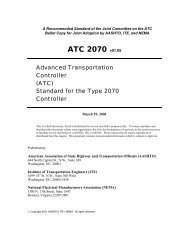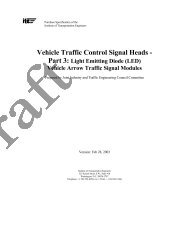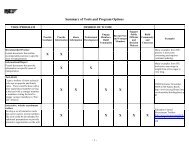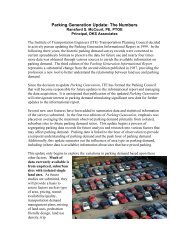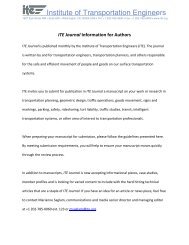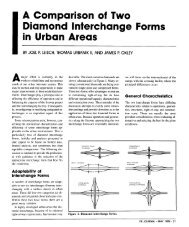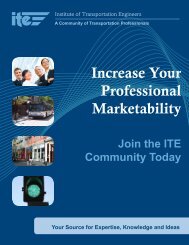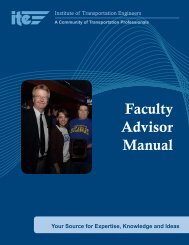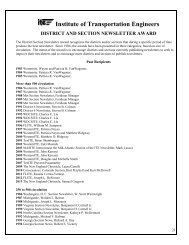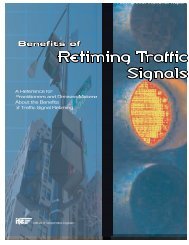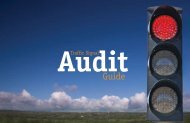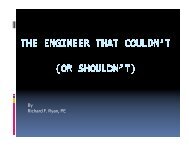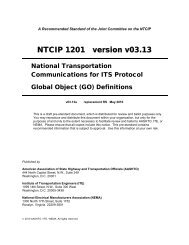speed control in residential areas - Institute of Transportation ...
speed control in residential areas - Institute of Transportation ...
speed control in residential areas - Institute of Transportation ...
You also want an ePaper? Increase the reach of your titles
YUMPU automatically turns print PDFs into web optimized ePapers that Google loves.
SPEED CONTROL IN<br />
RESIDENTIAL AREAS
FORWARD<br />
This document is a revision <strong>of</strong> the “Speed Control <strong>in</strong> Residential<br />
Areas” booklet orig<strong>in</strong>al written by the Residential Area Speed<br />
Control Ad-Hoc Committee. This revision represents the latest<br />
<strong>in</strong>formation and f<strong>in</strong>d<strong>in</strong>gs <strong>of</strong> the <strong>Institute</strong> <strong>of</strong> <strong>Transportation</strong> Engi-<br />
neers (ITE) Michigan Section’s Technical Project Committee.<br />
The makeup <strong>of</strong> the Technical Project Committee is as follows:<br />
Lori Swanson, Chair Hubbell, Roth & Clark, Inc.<br />
John Abraham City <strong>of</strong> Troy<br />
Matthew Smith McNamee, Porter & Seeley, Inc.<br />
Mshadoni Smith Hubbell, Roth & Clark, Inc.<br />
Eric Tripi Barton-Aschman Associates, Inc.<br />
<strong>of</strong> Michigan<br />
The <strong>in</strong>formation presented <strong>in</strong> this document represents the f<strong>in</strong>d-<br />
<strong>in</strong>gs <strong>of</strong> the authors and does not necessarily reflect the views <strong>of</strong><br />
the Michigan Office <strong>of</strong> Highway Safety Plann<strong>in</strong>g.<br />
I
TABLE OF CONTENTS<br />
I. INTRODUCTION . . . . . . . . . . . . . . . . . . . . . . . . . . . . . . . . . . ..a..... 1<br />
II. COMMUNITY INVOLVEMENT . . . . . . . . . . . . . . . . . . . . . 4<br />
Ill. PROBLEM IDENTIFICATION . . . . . . . . . . . . . . . . . . . . . . . 7<br />
IV. EDUCATION AND ENFORCEMENT . . . . . . . . . . . . 8<br />
A. EDUCATION . . . ..*...................................... 8<br />
1. Public Information and Education<br />
2. Neighborhood Speed Watch<br />
Program<br />
3. Radar Trailer<br />
B. ENFORCEMENT . . . . . . . . . . . . . . . . . . . . . . . . . . . . . . . . . . . 10<br />
1. Surveillance/Enforcement<br />
2. Automated Speed Enforcement<br />
Device<br />
V. ENGINEERING *.........................**............... 12<br />
ii<br />
A. TRAFFIC CONTROL DEVICES .e........... 12<br />
1. Stop Signs<br />
2. Speed Limit Signs<br />
3. Turn Prohibitions<br />
4. One-Way Streets<br />
5. Commercial Vehicle Prohibitions<br />
6. Special Warn<strong>in</strong>g Signs<br />
7. Portable Signs<br />
B. TRAFFIC CALMING DEVICES . . . . . . . . . . . . . . 21<br />
1. Speed Humps and Bumps<br />
2. Rumble Strips<br />
3. Cul-de-Sacs and Street Closures<br />
4. Traffic Diverters<br />
5. Traffic Islands<br />
6. Chokers and Road Narrow<strong>in</strong>g<br />
7. On-Street Park<strong>in</strong>g
C. ROADWAY MARKINGS . . . . . . . . . . . ..s........... 30<br />
1. Transverse Mark<strong>in</strong>gs<br />
2. Longitud<strong>in</strong>al Mark<strong>in</strong>gs<br />
3. Crosswalks<br />
D. PLANNING RELATED<br />
ALTERNATIVES . . . . . . . . . . . . . . . . . . ..*............... 32<br />
1. Adequate Arterial Capacity<br />
2. New Subdivision Plann<strong>in</strong>g<br />
VI. CONCLUSIONS . . . . . . . . . . . . . ..*........................*. 34<br />
. . .<br />
III
I. INTRODUCTION<br />
The perception <strong>of</strong> <strong>speed</strong><strong>in</strong>g on local streets is probably the most<br />
persistent problem fac<strong>in</strong>g residents and traffic <strong>of</strong>ficials, alike.<br />
Although local or <strong>residential</strong> streets carry the lowest traffic vol-<br />
umes and suffer the fewest traffic crashes, they are the s<strong>in</strong>gle<br />
largest consumer <strong>of</strong> a traffic eng<strong>in</strong>eer’s time and energy. Resi-<br />
dents observe vehicles be<strong>in</strong>g driven at <strong>speed</strong>s they perceive are<br />
too fast and conclude that the <strong>speed</strong>s would decrease if stop<br />
signs were <strong>in</strong>stalled. Speeds considered excessive by residents<br />
are considered reasonable by these same persons when they are<br />
driv<strong>in</strong>g <strong>in</strong> another neighborhood. Every traffic eng<strong>in</strong>eer has been<br />
shaken by these same residents who announce “if someth<strong>in</strong>g is<br />
not done about the traffic problem on my street, someone is go<strong>in</strong>g<br />
to be killed and it will be your fault.” This is usually followed by a<br />
demand for various traffic <strong>control</strong> measures and <strong>of</strong>ten backed up<br />
with petitions from residents. Traffic <strong>of</strong>ficials then must focus<br />
their attention on respond<strong>in</strong>g to these pressures, <strong>of</strong>ten divert<strong>in</strong>g<br />
resources that could be dedicated to solv<strong>in</strong>g major capacity and<br />
traffic crash problems on other streets.<br />
Residents’ compla<strong>in</strong>ts are usually accompanied by a proposed<br />
solution to the <strong>speed</strong><strong>in</strong>g problem...stop signs. Traffic <strong>of</strong>ficials<br />
respond that stop signs <strong>in</strong>stalled to <strong>control</strong> <strong>speed</strong><strong>in</strong>g: (a) don’t<br />
work, (b) are frequently violated, (c) are detrimental to safety,<br />
(d) are not warranted <strong>in</strong> the Manual* and, (e) actually <strong>in</strong>crease<br />
<strong>speed</strong>s between stop signs. When residents are told that stop<br />
signs are not the answer to the <strong>speed</strong><strong>in</strong>g problem, they feel they<br />
must fight city hall to get them <strong>in</strong>stalled. A confrontational<br />
relationship is established between residents and traffic <strong>of</strong>ficials<br />
and the stop sign becomes a “trophy” which is awarded to the<br />
w<strong>in</strong>ner <strong>of</strong> the confrontation. Solv<strong>in</strong>g the <strong>speed</strong><strong>in</strong>g problem be-<br />
comes secondary to w<strong>in</strong>n<strong>in</strong>g the “trophy”. The end results <strong>of</strong> this<br />
process are: (1) unhappy citizens, (2) cont<strong>in</strong>ued compla<strong>in</strong>ts and<br />
requests for more stop signs, (3) <strong>in</strong>creased political pressure and,<br />
(4) <strong>of</strong>ten, approval <strong>of</strong> stop sign <strong>in</strong>stallations to br<strong>in</strong>g the contro-<br />
versy, temporarily, to an end. However, experience shows the<br />
* The “Manual” refers to the Michigan Manual <strong>of</strong> Uniform Traffic Control<br />
Devices (MMUTCD that specifically states that stop signs should not be<br />
used for <strong>speed</strong> <strong>control</strong>).<br />
1
<strong>speed</strong><strong>in</strong>g problem is usually not solved. Before and after studies<br />
show that stop signs usually <strong>in</strong>crease mid-block <strong>speed</strong>s and<br />
create violators <strong>of</strong> the stop <strong>control</strong>s.<br />
This booklet <strong>in</strong>troduces traffic eng<strong>in</strong>eers, law enforcement <strong>of</strong>fi-<br />
cers, elected <strong>of</strong>ficials and community leaders to the concept <strong>of</strong><br />
traffic calm<strong>in</strong>g which may help alleviate <strong>speed</strong><strong>in</strong>g <strong>in</strong> <strong>residential</strong><br />
<strong>areas</strong>. Traffic calm<strong>in</strong>g is the comb<strong>in</strong>ation <strong>of</strong> physical <strong>control</strong>s and<br />
community support to reduce the negative effects <strong>of</strong> motor<br />
vehicle use, alter driver behavior and improve conditions for<br />
non-motorized users. Some objectives <strong>of</strong> traffic calm<strong>in</strong>g <strong>in</strong>clude:<br />
reduc<strong>in</strong>g <strong>speed</strong>s for motor vehicles, reduc<strong>in</strong>g crash frequency<br />
and severity, <strong>in</strong>creas<strong>in</strong>g safety, reduc<strong>in</strong>g the need for police<br />
enforcement, and reduc<strong>in</strong>g cut-through motor vehicle traffic.<br />
Traffic calm<strong>in</strong>g measures are typically <strong>in</strong>stalled as part <strong>of</strong> an area<br />
wide traffic management scheme rather than on a s<strong>in</strong>gle street to<br />
avoid shift<strong>in</strong>g the problem from one street to another. A success-<br />
ful traffic calm<strong>in</strong>g program must <strong>in</strong>clude enforcement, education,<br />
eng<strong>in</strong>eer<strong>in</strong>g and community <strong>in</strong>volvement. Community support<br />
and participation is an <strong>in</strong>tegral part <strong>of</strong> a successful traffic calm<strong>in</strong>g<br />
program. This booklet will give guidance on how to set up a<br />
successful traffic calm<strong>in</strong>g program <strong>in</strong> your community.<br />
This booklet provides alternatives that may help decrease <strong>speed</strong>s<br />
on <strong>residential</strong> streets. It discusses the advantages and disadvan-<br />
tages <strong>of</strong> each alternative. It po<strong>in</strong>ts out that there is no s<strong>in</strong>gle,<br />
simple solution to all <strong>speed</strong><strong>in</strong>g problems that satisfies residents, is<br />
effective, and meets good eng<strong>in</strong>eer<strong>in</strong>g practices and standards.<br />
It also stresses that there may not be a tool to reduce <strong>speed</strong>s.<br />
Regardless <strong>of</strong> the approach used, there are certa<strong>in</strong> criteria that<br />
should be followed:<br />
l All devices must meet Michigan Manual <strong>of</strong> Uniform Traffic<br />
Control DeviGes requirements.<br />
l The <strong>in</strong>tegrity <strong>of</strong> streets classified as Major under the provi-<br />
sions <strong>of</strong> Public Act 51 must be preserved.<br />
l Permanent traffic <strong>control</strong> devices should be used to the m<strong>in</strong>i-<br />
mum extent required to achieve the objectives.<br />
2
Access to all properties must be accommodated.<br />
Access from the nearest arterial to the dest<strong>in</strong>ation should be<br />
as direct as practical.<br />
Local access to neighborhood facilities must be accommo-<br />
dated.<br />
All permanently <strong>in</strong>stalled devices must be designed to allow<br />
emergency vehicle access.<br />
Consideration must be given to circulation, park<strong>in</strong>g and<br />
needs <strong>of</strong> customers and bus<strong>in</strong>ess owners.<br />
Consideration should be given to the access needs <strong>of</strong> essen-<br />
tial commercial services such as garbage pickup, snow plow-<br />
<strong>in</strong>g, student bus<strong>in</strong>g, etc.<br />
Changes must not unduly impact adjacent <strong>areas</strong>.<br />
It states that residents and local <strong>of</strong>ficials must work together with<br />
a full understand<strong>in</strong>g <strong>of</strong> each other’s problems, limitations and<br />
concerns for the common goal <strong>of</strong> safety on <strong>residential</strong> streets.<br />
One <strong>of</strong> the best ways to accomplish this is to have citizens<br />
<strong>in</strong>volved <strong>in</strong> stand<strong>in</strong>g or ad hoc community traffic safety commit-<br />
tees.<br />
This booklet is <strong>in</strong>tended to be used as a traffic safety tool by<br />
traffic eng<strong>in</strong>eers, law enforcement <strong>of</strong>ficers, elected <strong>of</strong>ficials, and<br />
community leaders <strong>in</strong> their day-to-day traffic <strong>control</strong> responsibili-<br />
ties.<br />
References: 40, 41, 42<br />
3
II. COMMUNITY INVOLVEMENT<br />
An important component <strong>of</strong> any traffic calm<strong>in</strong>g program is com-<br />
munity <strong>in</strong>volvement. If citizens are <strong>in</strong>volved, the chance for<br />
problem resolution and a successful traffic calm<strong>in</strong>g program is<br />
greatly improved. Often the problem cited is one <strong>of</strong> perception<br />
and not fact, and the solution proposed could be <strong>in</strong>effective or<br />
even counter-productive. One way to avoid the knee-jerk ap-<br />
proach to traffic eng<strong>in</strong>eer<strong>in</strong>g is to develop a process that <strong>in</strong>volves<br />
the community. While there are many ways to accomplish public<br />
<strong>in</strong>volvement, this section will describe two that have been suc-<br />
cessful.<br />
Aooroaches to Citizen Involvement<br />
Stand<strong>in</strong>g Committee<br />
Some communities have successfully employed a stand<strong>in</strong>g com-<br />
mittee, normally referred to as the “Citizen Traffic Committee,” to<br />
deal with traffic <strong>control</strong> issues. The makeup, function and<br />
authority <strong>of</strong> the committee are described below:<br />
a. The committee is appo<strong>in</strong>ted by the mayor or council. It<br />
should consist <strong>of</strong> an odd number <strong>of</strong> members who serve<br />
staggered terms.<br />
b. Non-vot<strong>in</strong>g staff experts (police and eng<strong>in</strong>eers) are available<br />
to prepare agendas, collect data, provide <strong>in</strong>put and send rec-<br />
ommendations to the city council.<br />
c. Efforts should be undertaken to make committee members<br />
as knowledgeable as possible about traffic eng<strong>in</strong>eer<strong>in</strong>g and<br />
enforcement pr<strong>in</strong>ciples. This can be realized by provid<strong>in</strong>g<br />
technical materials and tra<strong>in</strong><strong>in</strong>g for committee members.<br />
d. The Committee reviews citizen requests for traffic <strong>control</strong><br />
devices and staff analysis <strong>of</strong> those requests, and makes rec-<br />
ommendations to the city council.<br />
4
The Committee should hold monthly, even<strong>in</strong>g meet<strong>in</strong>gs. The<br />
stand<strong>in</strong>g committee <strong>of</strong>fers several advantages; acts as a buffer<br />
between the council and citizens; lessens the pressure to <strong>in</strong>stall<br />
unwarranted devices; may be perceived as more objective than<br />
staff; provides technical and citizen <strong>in</strong>put to the council; and<br />
dampens the adversary relationship that <strong>of</strong>ten develops between<br />
citizens and staff. On the other hand, there are some drawbacks:<br />
the committee can become politically motivated; one strong<br />
member can have too much <strong>in</strong>fluence; it can slow the process;<br />
and it requires some staff time.<br />
Ad hoc committee<br />
In this approach, an ad hocor advisory committee is formed when<br />
a community seeks help <strong>in</strong> deal<strong>in</strong>g with a specific traffic <strong>control</strong><br />
problem. While the governmental agency has the ultimate<br />
responsibility, it is highly desirable that the committee and agency<br />
work through the process and arrive at a consensus. This<br />
process works as follows:<br />
a. A work<strong>in</strong>g committee <strong>of</strong> neighborhood residents should be<br />
selected to represent different parts <strong>of</strong> the neighborhood. If<br />
the neighborhood has an organized association it should be<br />
asked to assist with the appo<strong>in</strong>tments; otherwise, volunteers<br />
are sought.<br />
b. Committee members should identify the problem brought to<br />
their attention.<br />
c. Staff collects the appropriate data and presents it to the com-<br />
mittee. The committee sets goals which are quantifiable,<br />
e.g., reduce the average <strong>speed</strong> by a certa<strong>in</strong> percentage, etc.<br />
d. Options should be identified and alternatives presented, list-<br />
<strong>in</strong>g the pros, cons, cost, etc. <strong>of</strong> each.<br />
e. Committee and staff reach agreement on the alternative to<br />
be recommended.<br />
f. Committee with staff support presents the plan to the larger<br />
community through a large meet<strong>in</strong>g or several small meet-<br />
5
<strong>in</strong>gs. One large meet<strong>in</strong>g is enough if the plan is not contro-<br />
versial; the number <strong>of</strong> meet<strong>in</strong>gs should be directly related to<br />
the complexity <strong>of</strong> the plan. The purpose <strong>of</strong> the meet<strong>in</strong>gs is to<br />
obta<strong>in</strong> community support.<br />
g. Once community support is achieved the plan is imple-<br />
mented. If possible, it is best to <strong>in</strong>stall temporary measures<br />
to determ<strong>in</strong>e the impact. This allows for adjustments and<br />
even removal if it is obvious that the measures will not pro-<br />
duce the desired results.<br />
The advantages <strong>of</strong> us<strong>in</strong>g advisory committees are that they will<br />
help develop neighborhood concerns and determ<strong>in</strong>e what, if<br />
anyth<strong>in</strong>g, should be done; it builds a relationship between staff<br />
and residents to work through future problems; and the process<br />
creates a better understand<strong>in</strong>g <strong>of</strong> traffic eng<strong>in</strong>eer<strong>in</strong>g and enforce-<br />
ment pr<strong>in</strong>ciples among lay people. Conversely, this process<br />
consumes considerable time and effort <strong>of</strong> staff. If consensus is<br />
not reached, the neighborhood can become divided. If not<br />
handled deftly by staff, the process can become unwieldy.<br />
References: 19, 25, 28<br />
6
Ill. PROBLEM IDENTIFICATION<br />
The first step <strong>in</strong> a traffic calm<strong>in</strong>g program is to identify the<br />
problem. When a resident contacts their City, Village or County,<br />
a compla<strong>in</strong>t is recorded. The resident will be directed to discuss<br />
their concerns with the other residents or an established traffic<br />
advisory committee. If an advisory committee has not been<br />
established, the public agency will give guidance on how to start<br />
one. Residents will assist the public agency <strong>in</strong> the identification <strong>of</strong><br />
the problem.<br />
These residents will also assist the public agency <strong>in</strong> the collection<br />
<strong>of</strong> data. Speed studies, traffic volume studies and license plate<br />
surveys, depend<strong>in</strong>g on need, will be performed at locations<br />
identified by the residents. The data collected will be analyzed to<br />
determ<strong>in</strong>e if there is a problem. If a problem is not identified, a<br />
letter with the support<strong>in</strong>g data will be sent to the residents<br />
expla<strong>in</strong><strong>in</strong>g the f<strong>in</strong>d<strong>in</strong>gs and that no further action is required. If a<br />
problem is identified, then the public agency will move to the<br />
next steps <strong>of</strong> the program which <strong>in</strong>clude enforcement and educa-<br />
tion.<br />
References: 42<br />
7
IV. EDUCATION AND ENFORCEMENT<br />
Once a <strong>speed</strong><strong>in</strong>g problem has been identified, the next steps <strong>in</strong> a<br />
traffic calm<strong>in</strong>g program is to <strong>in</strong>itiate education and enforcement<br />
campaigns. Both <strong>of</strong> these steps should be conducted at the same<br />
time s<strong>in</strong>ce many times a <strong>speed</strong><strong>in</strong>g problem can be reduced<br />
through effectively enforc<strong>in</strong>g the traffic ord<strong>in</strong>ances and educat<strong>in</strong>g<br />
the residents. From past enforcement activities, the City <strong>of</strong><br />
Farm<strong>in</strong>gton Hills, Michigan found that most traffic violators with<strong>in</strong><br />
a <strong>residential</strong> area were the residents who live <strong>in</strong> the area.<br />
Therefore, it is critical to educate the residents <strong>of</strong> an area where<br />
a traffic problem is occurr<strong>in</strong>g.<br />
Reference: 42<br />
A. EDUCATION<br />
1. Public Information And Education<br />
An effective way to educate residents is through public <strong>in</strong>forma-<br />
tion and education campaigns. Public <strong>in</strong>formation and education<br />
campaigns should be carried out through the mass media by law<br />
enforcement members <strong>of</strong> safety oriented groups. These cam-<br />
paigns “spread the word” about current enforcement emphasis<br />
and encourage voluntary compliance with the law. The percep-<br />
tion that violators will be apprehended is essential to develop<br />
compliance with the law. Select<strong>in</strong>g the right media for your<br />
message is important. Clearly def<strong>in</strong>e the reason for the change;<br />
i.e., to reduce traffic crash casualties. The size <strong>of</strong> the audience<br />
and project will be a <strong>control</strong>l<strong>in</strong>g factor <strong>in</strong> the media you select.<br />
An enforcement effort must be coord<strong>in</strong>ated with the <strong>in</strong>formation<br />
and education campaign.<br />
Reference: 5<br />
2. Neiahborhood Speed Watch Proaram<br />
Another educational tool is the Neighborhood Speed Watch<br />
Program whereby residents can help <strong>control</strong> <strong>speed</strong>s with m<strong>in</strong>imal<br />
police support.<br />
8
A Neighborhood Speed Watch Program must <strong>in</strong>volve law en-<br />
forcement personnel and residents work<strong>in</strong>g as a team. Law<br />
enforcement’s role is to provide the educational material and, if<br />
necessary traffic law enforcement. An effective tool used for<br />
education is <strong>speed</strong> radar trailers. The trailers are unmanned and<br />
equipped with radar equipment to detect the <strong>speed</strong> <strong>of</strong> vehicles.<br />
The trailer clocks the <strong>speed</strong> <strong>of</strong> an approach<strong>in</strong>g vehicle and<br />
displays the <strong>speed</strong> on a display board that is visible to the<br />
motorist. This shows the motorist the actual <strong>speed</strong> at which they<br />
are travel<strong>in</strong>g.<br />
The neighbors must educate each other, establish their goals, and<br />
police themselves. Neighbors identify the <strong>speed</strong>ers, the police<br />
make personal contact for the purpose <strong>of</strong> educat<strong>in</strong>g the <strong>speed</strong>er,<br />
and <strong>in</strong>volve law enforcement as a last resort.<br />
This program has the benefit <strong>of</strong> bond<strong>in</strong>g the neighborhood to-<br />
gether. The <strong>of</strong>f-shoots <strong>of</strong> this are <strong>in</strong>valuable. The reduction <strong>of</strong><br />
negative contacts with law enforcement enhances its image. The<br />
time <strong>in</strong>volvement will depend on the <strong>in</strong>dividual’s role and the size<br />
<strong>of</strong> neighborhood or community that is targeted. The media<br />
relationship <strong>in</strong>volvement relates to the target area.<br />
Neighborhood Speed Watch Programs rely on peer pressure and<br />
community spirit to <strong>in</strong>crease awareness <strong>in</strong> a subdivision that may<br />
experience <strong>speed</strong><strong>in</strong>g traffic. It considers the fact that <strong>in</strong> a<br />
self-conta<strong>in</strong>ed subdivision, the drivers <strong>in</strong>volved are neighbors and<br />
friends <strong>of</strong> the people compla<strong>in</strong><strong>in</strong>g <strong>of</strong> <strong>speed</strong><strong>in</strong>g. Neighborhood<br />
Speed Watch Programs have little or no effect on “through” traffic<br />
problems.<br />
Typically, to be <strong>in</strong>cluded <strong>in</strong> a Neighborhood Speed Watch Pro-<br />
gram, a street must (1) be a local street, (2) experience ~EJ’~<br />
percentile <strong>speed</strong>s <strong>in</strong> excess <strong>of</strong> 10 MPH greater than the posted<br />
<strong>speed</strong>, and (3) receive support from most <strong>of</strong> the households.<br />
Once established, the follow<strong>in</strong>g actions are taken:<br />
a) A personal letter is sent to all households expla<strong>in</strong><strong>in</strong>g the Pro-<br />
gram.<br />
9
) Neighborhood Speed Watch Program signs are posted.<br />
c) Committee members call each household <strong>in</strong> the specific area<br />
to expla<strong>in</strong> the program and appeal for cooperation.<br />
d) Radar <strong>speed</strong> observations are made by local traffic person-<br />
nel and personal letter are sent by the Chief <strong>of</strong> Police to<br />
drivers or owners <strong>of</strong> vehicles observed <strong>speed</strong><strong>in</strong>g.<br />
e) Periodic <strong>speed</strong> studies are made to determ<strong>in</strong>e the Program’s<br />
effectiveness.<br />
f) Neighborhood organizations are <strong>in</strong>volved as necessary.<br />
Reference: 9, 42<br />
B. ENFORCEMENT<br />
1. Surveillance/Enforcement<br />
Selective traffic law enforcement is the process <strong>of</strong> assign<strong>in</strong>g<br />
police <strong>of</strong>ficers to a specific area at specific times to enforce traffic<br />
laws relat<strong>in</strong>g to a specific problem. The allocation <strong>of</strong> <strong>of</strong>ficers to<br />
the area is usually for a limited period.<br />
When a police agency becomes aware <strong>of</strong> a particular traffic<br />
safety problem, <strong>of</strong>ficers can be assigned to the problem area to<br />
enforce related laws. Decisions must be made as to enforcement<br />
strategy, number <strong>of</strong> <strong>of</strong>ficers, time <strong>of</strong> day or any comb<strong>in</strong>ation<br />
there<strong>of</strong>, depend<strong>in</strong>g on the variables related to the location, type <strong>of</strong><br />
violations, available <strong>of</strong>ficers, etc.<br />
This type <strong>of</strong> activity tends to only solve the problem <strong>in</strong> the<br />
presence <strong>of</strong> the <strong>of</strong>ficer. The more <strong>of</strong>ficers assigned, the more<br />
effective this method. This is a costly process especially when it<br />
<strong>in</strong>volves overtime or divert<strong>in</strong>g <strong>of</strong>ficers from other assignments.<br />
IO
2. Automated Speed Enforcement Device<br />
The newest tool <strong>in</strong> <strong>speed</strong> enforcement is the Automated Speed<br />
Enforcement Device, which is currently be<strong>in</strong>g tested at selected<br />
locations throughout the U.S. This device consists <strong>of</strong> a <strong>speed</strong><br />
radar device and a 35 mm camera <strong>in</strong>terfaced through a com-<br />
puter. It is located <strong>in</strong> an unmarked vehicle parked on the side <strong>of</strong><br />
a road. As each vehicle comes with<strong>in</strong> radar range its <strong>speed</strong> is<br />
determ<strong>in</strong>ed. If that <strong>speed</strong> is over the preset threshold <strong>speed</strong>, the<br />
camera takes a photograph <strong>of</strong> the vehicle and its license plate.<br />
The owner <strong>of</strong> the vehicle is then <strong>in</strong>formed by either a warn<strong>in</strong>g<br />
letter or ticket <strong>of</strong> the date, time location, posted <strong>speed</strong> and travel<br />
<strong>speed</strong> <strong>of</strong> the vehicle. Currently, Michigan law does not permit the<br />
issuance <strong>of</strong> a ticket.<br />
11
V. ENGINEERING<br />
When the education and enforcement campaigns prove to be<br />
<strong>in</strong>effective, the location qualifies for further analysis to determ<strong>in</strong>e<br />
what traffic eng<strong>in</strong>eer<strong>in</strong>g measure, if any at all, should be <strong>in</strong>stalled<br />
to effectively reduce <strong>speed</strong>s. In certa<strong>in</strong> situations, vehicle <strong>speed</strong>s<br />
can only be effectively reduced by physical diversion <strong>of</strong> the traffic<br />
on the travelway. The application <strong>of</strong> traffic <strong>control</strong> devices, such<br />
as signs, alone normally are not effective <strong>in</strong> reduc<strong>in</strong>g vehicle<br />
<strong>speed</strong>s through <strong>residential</strong> neighborhoods. However, when used<br />
<strong>in</strong> conjunction with traffic calm<strong>in</strong>g devices, the proper use <strong>of</strong><br />
traffic <strong>control</strong> signs can be an effective traffic management tool.<br />
A. TRAFFIC CONTROL DEVICES<br />
1. Stop Signs<br />
The basic purpose <strong>of</strong> stop signs is to<br />
assign right-<strong>of</strong>-way to vehicles at <strong>in</strong>tersections.<br />
There are Stop Sign Warrants<br />
outl<strong>in</strong>ed <strong>in</strong> the MMUTCD which must be<br />
satisfied before a stop sign can be <strong>in</strong>stalled.<br />
Stop signs are requested by<br />
residents more than any other traffic<br />
<strong>control</strong> device for the reduction <strong>of</strong> vehicle<br />
<strong>speed</strong>s and traffic volumes. Unfortunately,<br />
studies have shown that stop<br />
signs are largely <strong>in</strong>effective<br />
<strong>speed</strong> <strong>control</strong>.<br />
<strong>in</strong> meet<strong>in</strong>g th e<br />
a. Two-Wav Stoo<br />
This is used to assign right-<strong>of</strong>-way to traffic on one <strong>of</strong> two<br />
<strong>in</strong>tersect<strong>in</strong>g streets by requir<strong>in</strong>g traffic on one street to come to a<br />
complete stop. It is suitable where:<br />
0 one street is a major street;<br />
. sight distances approach<strong>in</strong>g the <strong>in</strong>tersection are substandard,<br />
and traffic approach<strong>in</strong>g under the general rules for uncon-<br />
trolled <strong>in</strong>tersections would run a strong risk <strong>of</strong> be<strong>in</strong>g <strong>in</strong>volved<br />
<strong>in</strong> collisions;<br />
12
. there is a history <strong>of</strong> a crash pattern that could be corrected by<br />
right-<strong>of</strong>-way <strong>control</strong>s, yet conditions do not require traffic on<br />
both streets to stop.<br />
b. Four-Wav Stop<br />
This type <strong>of</strong> <strong>in</strong>tersection <strong>control</strong> is <strong>in</strong>tended primarily where two<br />
collector or major streets <strong>in</strong>tersect and do not warrant a traffic<br />
signal. Its purpose is to assign right-<strong>of</strong>-way to traffic on both<br />
<strong>in</strong>tersect<strong>in</strong>g streets by requir<strong>in</strong>g all approach<strong>in</strong>g vehicles to come<br />
to a complete stop.<br />
c. Effect on Traffic Volumes<br />
When local streets <strong>of</strong>fer significant sav<strong>in</strong>gs <strong>in</strong> time over con-<br />
gested parallel major and collector routes, or allow avoidance <strong>of</strong><br />
congestion po<strong>in</strong>ts, traffic <strong>control</strong> devices, <strong>in</strong>clud<strong>in</strong>g stop signs, will<br />
do little to reduce traffic volumes. However, when the local<br />
streets <strong>of</strong>fer only a slight sav<strong>in</strong>gs <strong>in</strong> travel time over other routes,<br />
the time lost at stop signs may be enough to keep traffic <strong>of</strong>f <strong>of</strong><br />
local <strong>residential</strong> streets.<br />
Stop signs may be <strong>in</strong>stalled at un<strong>control</strong>led <strong>in</strong>tersections <strong>in</strong><br />
<strong>residential</strong> neighborhoods with a street network arranged <strong>in</strong> a grid<br />
pattern. Traffic would be stopped on every other block throughout<br />
the entire <strong>residential</strong> neighborhood. With no cont<strong>in</strong>uous “through”<br />
streets <strong>in</strong> the neighborhood, an even distribution <strong>of</strong> traffic would<br />
be encouraged.<br />
d. Effect on Traffic Speed<br />
Numerous studies have shown that stop signs are relatively<br />
<strong>in</strong>effective as a <strong>speed</strong> <strong>control</strong> measure, except with<strong>in</strong> 150 feet <strong>of</strong><br />
the <strong>in</strong>tersection. At the po<strong>in</strong>t <strong>of</strong> <strong>in</strong>stallation, <strong>speed</strong>s are reduced,<br />
but the effect on traffic approach<strong>in</strong>g or leav<strong>in</strong>g the stop-<strong>control</strong>led<br />
<strong>in</strong>tersection is negligible. In fact, some motorists actually <strong>in</strong>-<br />
crease their <strong>speed</strong> to make up for the “<strong>in</strong>convenience” <strong>of</strong> stopp<strong>in</strong>g<br />
or disregard the stop signs. Studies show that more than 50% do<br />
not stop.<br />
13
A study conducted <strong>in</strong> Boulder, Colorado, demonstrated that the<br />
85th percentile <strong>speed</strong> and mean <strong>speed</strong>s on 25 mph and 35 mph<br />
roads were greater <strong>in</strong> <strong>areas</strong> that were <strong>control</strong>led by stop signs.<br />
Studies <strong>in</strong> various California cities showed a slight <strong>in</strong>crease, or no<br />
change, <strong>in</strong> vehicle <strong>speed</strong>s after the <strong>in</strong>stallation <strong>of</strong> stop signs.<br />
While the request for stop sign <strong>in</strong>stallation leads all resident<br />
requests for <strong>speed</strong> <strong>control</strong> measures, it must be emphasized that<br />
studies have proven there is little or no effect on vehicle <strong>speed</strong>s<br />
<strong>in</strong> <strong>residential</strong> road networks after <strong>in</strong>stallation.<br />
e. Warrants/Compliance<br />
Warrants for stop sign <strong>in</strong>stallations are <strong>in</strong>cluded <strong>in</strong> the Michigan<br />
Manual <strong>of</strong> Uniform Traffic Control Devices (MMUTCD). These<br />
warrants relate to right-<strong>of</strong>-way assignment and respond to site<br />
safety consideration.<br />
A stop sign observance study <strong>of</strong> unwarranted four-way stops <strong>in</strong><br />
Troy, Michigan, found that the percentage <strong>of</strong> “no” or “roll” stops to<br />
be significant after <strong>in</strong>stallation <strong>of</strong> unwarranted stop signs, while<br />
there was no significant change <strong>in</strong> 85th percentile <strong>speed</strong>s.<br />
Many studies have been conducted to determ<strong>in</strong>e the degree to<br />
which stop signs are obeyed. When not required to stop by cross<br />
street traffic, only 5 to 20 percent <strong>of</strong> all drivers come to a<br />
complete stop; 40 to 60 percent will come to a “roll<strong>in</strong>g” stop<br />
below 5 MPH, and 20 to 40 percent will pass through at higher<br />
<strong>speed</strong>s. High-volume, four way stop-<strong>control</strong>led <strong>in</strong>tersections<br />
have demonstrated the highest compliance levels, while three-<br />
way stop <strong>control</strong>led <strong>in</strong>tersections have shown the lowest.<br />
In Star City, West Virg<strong>in</strong>ia, before and after studies showed an<br />
<strong>in</strong>crease <strong>in</strong> “no-stops” from 14.1% to 25.1% when two-way stop<br />
<strong>in</strong>tersections were converted every summer to four-way stops for<br />
pedestrian safety. Mean Speed was not significantly affected by<br />
the presence <strong>of</strong> the four-way stops. The recommendation <strong>of</strong> this<br />
particular study was to end the practice <strong>of</strong> us<strong>in</strong>g four-way stops<br />
for <strong>speed</strong> <strong>control</strong>.
Studies have shown that when a driver does not believe that a<br />
stop sign appropriately reflects the actual traffic conditions, the<br />
driver <strong>of</strong>ten disregards it. The use <strong>of</strong> unwarranted stop signs not<br />
only decreases the compliance levels <strong>of</strong> motorists, but has the<br />
un<strong>in</strong>tended effect <strong>of</strong> decreas<strong>in</strong>g compliance at <strong>in</strong>tersections<br />
where stop signs have been <strong>in</strong>stalled for warranted operation and<br />
collision reduction.<br />
f. Effect on Traffic Safety<br />
While no study has proven the effectiveness <strong>of</strong> stop signs as<br />
traffic safety measures, general eng<strong>in</strong>eer<strong>in</strong>g belief is that the<br />
unwarranted use <strong>of</strong> stop signs <strong>in</strong>creases the safety hazard at the<br />
<strong>in</strong>tersection. This is shown <strong>in</strong> the studies <strong>of</strong> the compliance rates<br />
at stop-<strong>control</strong>led <strong>in</strong>tersections. In addition, motorists disregard<br />
for unwarranted stop signs presents a significant hazard to cross-<br />
<strong>in</strong>g pedestrians.<br />
Effects <strong>of</strong> unwarranted stop signs on driver behavior and safety at<br />
stop signs throughout a community are difficult to substantiate.<br />
Evidence to date on the safety effects <strong>of</strong> <strong>in</strong>dividual stop signs<br />
placed for volume and <strong>speed</strong> reduction purposes is mixed. At<br />
some <strong>in</strong>tersections where a degradation <strong>in</strong> safety was measured,<br />
placement <strong>of</strong> the signs <strong>in</strong> poor visibility positions and lack <strong>of</strong><br />
supplementary mark<strong>in</strong>gs may account for the crash experience.<br />
Cases where safety experience was reportedly improved may<br />
<strong>in</strong>clude <strong>in</strong>stances where traditional warrants for stop sign <strong>in</strong>stalla-<br />
tion were actually met, or were close to be<strong>in</strong>g met.<br />
g. Environmental Effects<br />
Stop signs affect the environment around the <strong>in</strong>tersection, and<br />
the use <strong>of</strong> unwarranted stops signs could unnecessarily add to<br />
this problem. Stopp<strong>in</strong>g and idl<strong>in</strong>g at <strong>in</strong>tersections <strong>in</strong>creases the<br />
amount <strong>of</strong> automobile exhaust <strong>in</strong> the area. In addition, tire noise<br />
and eng<strong>in</strong>e noise <strong>in</strong>crease with the brak<strong>in</strong>g and acceleration<br />
associated with stop signs. Automobile fuel consumption is<br />
<strong>in</strong>creased with the stopp<strong>in</strong>g, accelerat<strong>in</strong>g, and idl<strong>in</strong>g <strong>of</strong> vehicles at<br />
stop-<strong>control</strong>led <strong>in</strong>tersections.<br />
15
h. Community Reaction<br />
Residents <strong>of</strong>ten see stop signs as a solution to “near miss”, as<br />
well as actual crashes. They are also viewed as be<strong>in</strong>g effective<br />
at <strong>control</strong>l<strong>in</strong>g vehicle <strong>speed</strong>s. Suggestions that unwarranted stop<br />
signs have very poor compliance and that they might be detri-<br />
mental to safety are generally discounted by residents. Residents<br />
also dismiss concerns over a community’s exposure to tort<br />
liability for unwarranted use <strong>of</strong> traffic <strong>control</strong> devices. By disre-<br />
gard<strong>in</strong>g the warrants presented <strong>in</strong> the MMUTCD, this presents<br />
potential liability concerns for the responsible jurisdiction. If a<br />
stop sign <strong>in</strong>stallation could be considered irresponsible or <strong>in</strong> clear<br />
contradiction to accepted standards, liability suits could result.<br />
Objections to stop signs come ma<strong>in</strong>ly from residents at the<br />
<strong>in</strong>tersections who are subjected to additional noise and pollution<br />
which come from decelerat<strong>in</strong>g and accelerat<strong>in</strong>g vehicles, and<br />
from motorists who th<strong>in</strong>k they are be<strong>in</strong>g stopped needlessly.<br />
It should be the goal <strong>of</strong> the traffic eng<strong>in</strong>eer and local policy<br />
makers to expla<strong>in</strong> to the public why unwarranted stop signs are<br />
<strong>in</strong>effective at <strong>control</strong>l<strong>in</strong>g vehicle <strong>speed</strong>s. Special attention should<br />
be given to expla<strong>in</strong><strong>in</strong>g the adverse effects on the environment,<br />
motorist safety, and pedestrian safety.<br />
A community’s policy <strong>of</strong> <strong>in</strong>stall<strong>in</strong>g 4-way stops at school cross<strong>in</strong>gs<br />
should be reviewed <strong>in</strong> light <strong>of</strong> the above items. Stops at these<br />
locations are only useful about 2% <strong>of</strong> the time. Therefore, 98% <strong>of</strong><br />
the time, they can be serious traffic safety hazards.<br />
References: 1, 2, 3, 4, 36, 37, 38, 39, 40<br />
2. Speed Limit Sians<br />
a. Soeed Limit Sians/Soeed Zon<strong>in</strong>q<br />
I SPEED<br />
The <strong>speed</strong> limit sign is a regulatory device that LIMIT<br />
<strong>in</strong>forms drivers <strong>of</strong> the <strong>speed</strong> limit imposed by<br />
the govern<strong>in</strong>g agency. Some signs merely<br />
rem<strong>in</strong>d drivers <strong>of</strong> the limits applicable to the<br />
type <strong>of</strong> highway and area. Where the <strong>speed</strong> 25<br />
16
limit is not applicable to specific sites because <strong>of</strong> special hazards,<br />
a deviation from that limit is shown by post<strong>in</strong>g advisory <strong>speed</strong><br />
signs. A new <strong>speed</strong> limit is determ<strong>in</strong>ed by an eng<strong>in</strong>eer<strong>in</strong>g and<br />
traffic study <strong>of</strong> the street section <strong>in</strong>volved. Special attention is<br />
given to the character <strong>of</strong> the street (sidewalks, driveways, and<br />
sight obstructions), horizontal and vertical alignment, pedestrian<br />
activities, and hazards which may not be easily detected by<br />
drivers. If no unusual safety problems are detected, the 85th<br />
percentile <strong>speed</strong> <strong>of</strong> traffic on a street is usually taken as an<br />
<strong>in</strong>dication <strong>of</strong> the <strong>speed</strong> limit which could be implemented.<br />
Studies that tested the effect <strong>of</strong> <strong>speed</strong> limit signs on <strong>speed</strong>s have<br />
been largely conf<strong>in</strong>ed to major streets and expressways. Petfor-<br />
mance on these highways is not considered relevant to the local<br />
street situation. Studies have shown that <strong>speed</strong> limit signs have<br />
very little impact on drivers’ <strong>speed</strong>s on major streets. Motorists<br />
drive at <strong>speed</strong>s that they consider reasonable, comfortable,<br />
convenient and safe under exist<strong>in</strong>g conditions. Drivers appear<br />
not to operate their vehicles by the <strong>speed</strong>ometer, but by roadway<br />
conditions.<br />
Speed limit signs, other than the standard 5 MPH <strong>in</strong>crement (i.e.,<br />
28 MPH), are not standard and may be illegal.<br />
The desired effect <strong>of</strong> post<strong>in</strong>g a non-standard<br />
<strong>speed</strong> limit sign is to ga<strong>in</strong> compliance by<br />
captur<strong>in</strong>g the driver’s attention with a unique<br />
number. If drivers are consciously aware <strong>of</strong><br />
the <strong>speed</strong> limit, they are more likely to comply<br />
with it. While the signs are <strong>in</strong>expensive, they<br />
do not conform to the MMUTCD. Initially, the<br />
signs would be noticed and make drivers<br />
aware <strong>of</strong> their <strong>speed</strong>. Once drivers became<br />
used to the signs, they have no further effect on drivers’ <strong>speed</strong>s.<br />
If posted <strong>speed</strong> limits are significantly lower than prevail<strong>in</strong>g traffic<br />
<strong>speed</strong>, residents normally place some hope <strong>in</strong> them or <strong>in</strong> subse-<br />
quent enforcement. However, if the posted limits are with<strong>in</strong> a few<br />
miles per hour <strong>of</strong> the previously prevail<strong>in</strong>g traffic <strong>speed</strong>, they are<br />
not address<strong>in</strong>g the residents’ problem.<br />
17
. Speed Limit Sians With Other Devices<br />
Speed limit signs with flash<strong>in</strong>g beacons have been shown to have<br />
a m<strong>in</strong>or effect <strong>in</strong> reduc<strong>in</strong>g vehicular <strong>speed</strong>s. Such signs have<br />
been shown to be most effective <strong>in</strong> school zones. Other traffic<br />
activated signs with variable messages and warn<strong>in</strong>gs may also<br />
have m<strong>in</strong>or effectiveness <strong>in</strong> reduc<strong>in</strong>g <strong>speed</strong>s.<br />
One such device is a trailer-mounted variable message sign with<br />
a radar <strong>speed</strong> gun which displays the posted <strong>speed</strong> limit and the<br />
approach<strong>in</strong>g driver’s <strong>speed</strong>. The <strong>in</strong>tent is to <strong>in</strong>crease the mo-<br />
torists’ awareness <strong>of</strong> both posted <strong>speed</strong> limit and their own travel<br />
<strong>speed</strong>.<br />
Observations show that most motorists reduce their <strong>speed</strong> when<br />
they see the device. In addition to reduc<strong>in</strong>g motorists’ <strong>speed</strong>s,<br />
other advantages <strong>of</strong> the equipment <strong>in</strong>clude the creation <strong>of</strong> posi-<br />
tive public relations, better acceptance <strong>of</strong> <strong>speed</strong><strong>in</strong>g tickets, and its<br />
ability to act as a teach<strong>in</strong>g device. The disadvantages <strong>in</strong>clude<br />
potential vandalism to the equipment if left unattended, and it<br />
may encourage <strong>speed</strong><strong>in</strong>g by those who wish to “test” it. Its <strong>speed</strong><br />
reduction effectiveness is isolated to the immediate area and time<br />
<strong>of</strong> its use, and this likely will dim<strong>in</strong>ish over time. However,<br />
effectiveness can be improved with the use <strong>of</strong> visible <strong>speed</strong><br />
enforcement.<br />
References: 5, 6, 7<br />
3. Turn Prohibitions<br />
Turn prohibitions will reduce traffic volumes, noise, and, <strong>in</strong> some<br />
cases, <strong>speed</strong>s on streets where they are applied. They may also<br />
improve traffic safety on streets to which they are applied.<br />
However, volumes, noise and <strong>speed</strong>s<br />
will <strong>in</strong>crease on alternate routes. They<br />
are difficult to enforce, and reduce ac-<br />
cess for residents. In some cases,<br />
<strong>speed</strong>s may <strong>in</strong>crease, and traffic safety<br />
may decrease, when motorists are<br />
forced to take alternate routes.<br />
18
Turn prohibitions can be used to reduce traffic volumes on local<br />
streets by <strong>in</strong>stall<strong>in</strong>g them on major/collector streets to prevent<br />
traffic from enter<strong>in</strong>g local streets. Such <strong>control</strong>s are usually <strong>in</strong><br />
effect dur<strong>in</strong>g peak traffic volume hours, when motorists are<br />
seek<strong>in</strong>g less congested, alternate routes.<br />
Although turn prohibitions have been <strong>in</strong> use for some time, very<br />
little quantitative research was found, and it was related to the<br />
number <strong>of</strong> violations. Violations <strong>in</strong> the range <strong>of</strong> 10% to 15% <strong>of</strong><br />
the orig<strong>in</strong>al turn<strong>in</strong>g volume can be expected.<br />
Reference: 8<br />
4. One-Wav Streets<br />
The use <strong>of</strong> one-way streets has mixed results. They are not<br />
useful <strong>in</strong> reduc<strong>in</strong>g <strong>speed</strong>s on local streets. In fact, the use <strong>of</strong><br />
one-way signs may <strong>in</strong>crease <strong>speed</strong>s <strong>in</strong> the permitted direction,<br />
and may <strong>in</strong>crease the amount <strong>of</strong> cut-through traffic on other<br />
<strong>residential</strong> streets.<br />
One-way streets can be used to make travel through a neighbor-<br />
hood difficult by creat<strong>in</strong>g a maze effect <strong>in</strong> the <strong>in</strong>ternal street<br />
pattern, which may discourage through traffic. However, the<br />
amount <strong>of</strong> traffic on other <strong>residential</strong> streets may be <strong>in</strong>creased.<br />
Reference: 8<br />
5. Commercial Vehicle Prohibitions<br />
It is a common practice <strong>in</strong> communities to prohibit commercial<br />
vehicles from most, if not all, local streets <strong>in</strong> <strong>residential</strong> <strong>areas</strong>.<br />
This is done to protect the pavements and elim<strong>in</strong>ate nuisances.<br />
However, commercial vehicles are normally allowed to travel on<br />
any street when engaged <strong>in</strong> pickup and delivery. Such regula-<br />
tions are unlikely to affect vehicle <strong>speed</strong>s, but they will reduce<br />
truck traffic volume and noise.<br />
Reference: 8<br />
19
6. Special Warn<strong>in</strong>a Sians<br />
Special warn<strong>in</strong>g signs such as “Children at Play”, “Watch for<br />
Children”, or others that warn <strong>of</strong> normal conditions are not<br />
effective <strong>in</strong> reduc<strong>in</strong>g <strong>speed</strong>s <strong>in</strong> <strong>residential</strong> <strong>areas</strong>. It is also likely<br />
that such signs encourage parents to believe that there is an<br />
added degree <strong>of</strong> protection, which is not the case. These signs<br />
suggest that it is acceptable for children to play <strong>in</strong> the street. The<br />
Michigan Vehicle Code prohibits the use <strong>of</strong> signs not deemed<br />
standard by the MMUTCD.<br />
The MMUTCD provides standards for signs warn<strong>in</strong>g drivers that<br />
they are approach<strong>in</strong>g recreational facilities such as parks and<br />
playgrounds. However, there is not enough evidence to deter-<br />
m<strong>in</strong>e the effect <strong>of</strong> these warn<strong>in</strong>g signs on vehicle <strong>speed</strong>s.<br />
Reference: 40<br />
7. Portable Sians<br />
One grow<strong>in</strong>g trend <strong>in</strong> many communities is the use <strong>of</strong> portable<br />
stop signs placed <strong>in</strong> the street between crosswalks, to protect<br />
pedestrians. This has actually turned out to be a very controver-<br />
sial issue <strong>in</strong> many <strong>areas</strong>.<br />
Municipalities feel that these signs are very effective <strong>in</strong> forc<strong>in</strong>g<br />
traffic to stop for pedestrians <strong>in</strong> crosswalks. However, some state<br />
departments <strong>of</strong> transportation have banned the use <strong>of</strong> these<br />
portable signs, cit<strong>in</strong>g reports that the signs, when hit by vehicles,<br />
have caused <strong>in</strong>juries to nearby pedestrians. The MMUTCD states<br />
“As noted here<strong>in</strong> or for emergency purposes, portable or part-time<br />
STOP signs shall not be used”. The exceptions refer to hand-<br />
held STOP signs used by construction flaggers and school cross-<br />
<strong>in</strong>g guards.<br />
20
B. TRAFFIC CALMING DEVICES<br />
1. Speed Humps and Bumps<br />
The <strong>speed</strong> hump is generally 3 to 4 <strong>in</strong>ches high, rounded section<br />
<strong>of</strong> pavement, approximately 12 feet <strong>in</strong> length. A <strong>speed</strong> bump is<br />
approximately 12” to 18” long, caus<strong>in</strong>g a more severe “bump” to<br />
be felt by the driver.<br />
The <strong>speed</strong> hump was developed <strong>in</strong> the <strong>Transportation</strong> Road<br />
Research Laboratories (TRRL) <strong>in</strong> Great Brita<strong>in</strong> and has been<br />
tested <strong>in</strong> closed test <strong>areas</strong> and on public roads. Tests <strong>in</strong> the<br />
United States and <strong>in</strong> various countries around the world, have<br />
shown <strong>speed</strong> humps to be effective <strong>in</strong> <strong>control</strong>l<strong>in</strong>g vehicle <strong>speed</strong>s<br />
and <strong>in</strong> reduc<strong>in</strong>g traffic volumes <strong>in</strong> the immediate area <strong>of</strong> the<br />
hump or bump.<br />
Studies <strong>in</strong> Australia, the United K<strong>in</strong>gdom, and the United States<br />
have shown reductions <strong>in</strong> 85’h percentile <strong>speed</strong>s rang<strong>in</strong>g from 3<br />
MPH to 14 MPH between <strong>speed</strong> humps and from 6 MPH to 27<br />
MPH at the <strong>speed</strong> hump location. Recent experience <strong>in</strong> a<br />
Michigan community <strong>in</strong>dicated a 5 mph reduction <strong>in</strong> the 85’h<br />
percentile <strong>speed</strong>. Volumes were found to be reduced from 1 to<br />
55 percent.<br />
SPEED<br />
BUMP<br />
SPEED HUMP<br />
Another type <strong>of</strong> <strong>speed</strong> hump is the flat top hump or <strong>speed</strong> table.<br />
These humps are typically 22 <strong>in</strong>ches long with a 10 foot flat<br />
21
section and can be used on collector roads with more than 12,000<br />
vehicles per day. This type <strong>of</strong> <strong>speed</strong> hump can serve as<br />
pedestrian cross<strong>in</strong>gs. Studies have shown these humps not only<br />
greatly reduce the 85’h percentile <strong>speed</strong> <strong>of</strong> ma<strong>in</strong>stream traffic but<br />
also have shown that, unlike <strong>speed</strong> humps, the <strong>speed</strong> between<br />
the humps and at the humps are essentially the same as before<br />
hump or bump <strong>in</strong>stallation.<br />
Some <strong>of</strong> the negative effects <strong>of</strong> <strong>speed</strong> humps are an <strong>in</strong>crease <strong>in</strong><br />
noise level from <strong>in</strong>dividual vehicles near the humps caused by<br />
brak<strong>in</strong>g and acceleration, but not due to the sound <strong>of</strong> vehicles<br />
strik<strong>in</strong>g the humps. Studies have shown that <strong>speed</strong> humps have<br />
a more severe impact on longer wheel base vehicles and should<br />
not be used on neighborhood collectors, major fire and ambu-<br />
lance routes, or on routes frequently used by large trucks or<br />
buses. They are a major h<strong>in</strong>drance to snowplow<strong>in</strong>g efforts.<br />
Often the implementation <strong>of</strong> such traffic calm<strong>in</strong>g measures br<strong>in</strong>g<br />
up liability issues. A recent survey <strong>of</strong> a number <strong>of</strong> communities<br />
us<strong>in</strong>g different traffic calm<strong>in</strong>g devices found that most had no<br />
legal problems at all while the rema<strong>in</strong>der had mostly experienced<br />
threats and no action. As more and more traffic calm<strong>in</strong>g devices<br />
are <strong>in</strong>stalled, the question <strong>of</strong> the legality <strong>of</strong> these measures are<br />
becom<strong>in</strong>g irrelevant.<br />
The reports on <strong>speed</strong> humps have shown that both the design and<br />
location/spac<strong>in</strong>g <strong>of</strong> <strong>speed</strong> humps are critical. For typical residen-<br />
tial streets the most widely used design is the circular, parabolic<br />
<strong>speed</strong> hump. A series <strong>of</strong> <strong>speed</strong> humps is more effective than a<br />
s<strong>in</strong>gle <strong>in</strong>stallation. The spac<strong>in</strong>g <strong>of</strong> <strong>speed</strong> humps ranges from 200<br />
feet to 750 feet, depend<strong>in</strong>g upon the desired 85’h percentile <strong>speed</strong><br />
between <strong>speed</strong> humps. Formulas have been developed to<br />
determ<strong>in</strong>e the optimal spac<strong>in</strong>g <strong>of</strong> humps, depend<strong>in</strong>g on the use <strong>of</strong><br />
either a 3 <strong>in</strong>ch or a 4 <strong>in</strong>ch high hump. Adequate pavement<br />
mark<strong>in</strong>gs and traffic signs are important to warn drivers <strong>of</strong> <strong>speed</strong><br />
humps. Speed humps can be <strong>in</strong>stalled on roadways carry<strong>in</strong>g<br />
3,000-8,000 vehicles per day. The cross-section design <strong>of</strong> humps<br />
or bumps is critical to their effectiveness.<br />
The <strong>speed</strong> hump should not be confused with the <strong>speed</strong> bump<br />
that is 3 to 5 <strong>in</strong>ches <strong>in</strong> height and 1 to 1 % feet <strong>in</strong> length. Because<br />
<strong>speed</strong> bumps are abrupt, they are considered to be potentially<br />
hazardous for motor vehicles. The ma<strong>in</strong> use <strong>of</strong> the <strong>speed</strong> bump<br />
22
has been <strong>in</strong> private park<strong>in</strong>g lots and on private roads. They are<br />
generally considered to be <strong>in</strong>appropriate by traffic eng<strong>in</strong>eers<br />
because they are not <strong>in</strong>cluded <strong>in</strong> design guides.<br />
As <strong>of</strong> September 10, 1997, The <strong>Institute</strong> <strong>of</strong> <strong>Transportation</strong> Engi-<br />
neers (ITE) plans to publish the recommended practices for<br />
Guidel<strong>in</strong>es for the Design and Application <strong>of</strong> Speed Humps.<br />
References: 10, 11, 12, 13, 14, 15, 16, 32, 33<br />
2. Rumble Strips<br />
Rumble strips are a series <strong>of</strong> either bumps or depressions <strong>in</strong> the<br />
pavement. They are <strong>in</strong>tended to alert drivers <strong>of</strong> a special<br />
situation, such as a <strong>speed</strong> reduction or stop ahead condition.<br />
They are typically ‘/2 to 1 ‘/2 <strong>in</strong>ches high or deep, 3 to 4 <strong>in</strong>ches<br />
wide and placed 90” to traffic flow.<br />
Rumble strips produce both an audible rumble and a vibration<br />
that creates an awareness <strong>of</strong> a condition for which a driver must<br />
react. They are used most frequently on shoulders <strong>of</strong> high-<strong>speed</strong><br />
roadways to alert drivers that they are not driv<strong>in</strong>g <strong>in</strong> the travel<br />
lanes <strong>of</strong> a road. They are also commonly used to alert drivers <strong>in</strong><br />
rural or high <strong>speed</strong> <strong>areas</strong> <strong>of</strong> an unexpected stop-ahead condition.<br />
Many states now use ‘portable’ rumble strips, which are basically<br />
high density rubber sheets with a series <strong>of</strong> undulations, Though<br />
these are popularly used near construction zones, these may be<br />
used as a temporary measure <strong>in</strong> <strong>residential</strong> <strong>areas</strong> before <strong>in</strong>stall<strong>in</strong>g<br />
permanent rumble strips.<br />
Little research has been performed <strong>in</strong> <strong>residential</strong> <strong>areas</strong> for their<br />
use as a <strong>speed</strong> <strong>control</strong> device. A study <strong>in</strong> the City <strong>of</strong> Rochester<br />
Hills showed <strong>speed</strong> reductions <strong>of</strong> up to 2 MPH, whereas another<br />
study showed reductions <strong>of</strong> up to 15 MPH. Rumble strips can<br />
produce an annoy<strong>in</strong>g noise, cause vibration <strong>in</strong> nearby homes and<br />
be snow removal obstructions. One study suggests they should<br />
not be used where there is significant bus or truck activity or<br />
where traffic volumes exceed 2,500 vehicles per day. Due to the<br />
adverse effects, their <strong>in</strong>stallation must be carefully considered.<br />
References: 4, 17, 18<br />
23
3. Street Closures<br />
The primary effect <strong>of</strong> street closures is to elim<strong>in</strong>ate through traffic<br />
rather than to reduce <strong>speed</strong>. There may be some <strong>speed</strong> reduc-<br />
tion because higher <strong>speed</strong><br />
through traffic is discouraged<br />
from us<strong>in</strong>g the neighborhood<br />
streets. This is true particularly<br />
where a pattern <strong>of</strong> closures is<br />
carefully designed to accom-<br />
plish this end. Street closures<br />
can be constructed at an <strong>in</strong>ter-<br />
section or at midblock. The<br />
midblock application can be ef-<br />
fectively used where it is desired<br />
to restrict traffic <strong>in</strong> a <strong>residential</strong><br />
section while allow<strong>in</strong>g access to<br />
a high traffic generator adjacent I<br />
to the <strong>residential</strong> area. Gener- ,<br />
ally, whenever a street closure<br />
is used, a cul-de-sacs should be<br />
constructed so as not to “trap” a<br />
vehicle. Cul-de-sacs <strong>of</strong>ten require the purchase <strong>of</strong> right-<strong>of</strong>-way<br />
and <strong>of</strong>ten are constructed <strong>in</strong> a resident’s front yard.<br />
Among the disadvantages <strong>of</strong> street closures are:<br />
. Restricted access to the neighborhood by service and emer-<br />
gency vehicles.<br />
l Problems with vandalism and ma<strong>in</strong>tenance.<br />
l Traffic is <strong>of</strong>ten transferred to neighbor<strong>in</strong>g streets, generat<strong>in</strong>g<br />
new problems and compla<strong>in</strong>ts.<br />
Street closures are difficult to apply to exist<strong>in</strong>g roadways and are<br />
better suited for newly develop<strong>in</strong>g subdivisions.<br />
When cul-de-sacs are used, adequate turnaround <strong>areas</strong> must be<br />
provided at the end <strong>of</strong> the street. Proper signs must be <strong>in</strong>stalled<br />
to warn drivers <strong>of</strong> the end <strong>of</strong> the street.<br />
Reference: 8, 28<br />
24
4. Traffic Diverters<br />
a. Diagonal Diverters<br />
Diagonal diverters are barriers<br />
placed diagonally across an <strong>in</strong>ter-<br />
section. This converts a normal<br />
four-legged <strong>in</strong>tersection <strong>in</strong>to two<br />
separate roadways, each with a 90”<br />
turn. The purpose is to discourage<br />
“through” traffic by requir<strong>in</strong>g it to<br />
take a circuitous route through the<br />
neighborhood.<br />
Speeds <strong>of</strong> vehicles are only affected <strong>in</strong> the immediate vic<strong>in</strong>ity <strong>of</strong><br />
the diverter because drivers must make a 90” turn. Diverters<br />
may discourage drivers from us<strong>in</strong>g the street as a short-cut route.<br />
However, some drivers will simply move to another <strong>residential</strong><br />
street, thus mov<strong>in</strong>g the problem. S<strong>in</strong>ce they create formidable<br />
barriers <strong>in</strong> the <strong>in</strong>tersection, they must be marked similar to<br />
one-way streets and have appropriate lights so they can be seen<br />
at night.<br />
References: 8, 9, 19<br />
b. Semi-Diverters<br />
A semi-diverter is a barrier placed transverse to traffic at the<br />
beg<strong>in</strong>n<strong>in</strong>g <strong>of</strong> a block. It prohibits traffic from enter<strong>in</strong>g the block,<br />
but allows two-way traffic with<strong>in</strong> the block. S<strong>in</strong>ce they create<br />
formidable barriers <strong>in</strong> the <strong>in</strong>tersection, they must be marked<br />
similar to one-way streets and have appropriate lights so they can<br />
be seen at night.<br />
Semi-diverters have no effect on <strong>speed</strong>s other than <strong>in</strong> the imme-<br />
diate vic<strong>in</strong>ity <strong>of</strong> the barrier. They can reduce traffic volumes, but<br />
only at the end <strong>of</strong> the block at which they are placed. The<br />
violation <strong>in</strong>cidence can be quite high.<br />
Reference: 8, 19<br />
25
I 26<br />
5. Traffic Islands<br />
a. Traffic Roundabout<br />
Modern roundabouts are different from traditional traffic circles, <strong>in</strong><br />
that all approach<strong>in</strong>g traffic yields right <strong>of</strong> way to circulat<strong>in</strong>g traffic.<br />
This is re<strong>in</strong>forced through the use <strong>of</strong> yield signs on the approaches.<br />
Other characteristics <strong>of</strong><br />
roundabouts <strong>in</strong>clude deflection and<br />
flared approaches. Use <strong>of</strong> deflection<br />
helps slow enter<strong>in</strong>g vehicles,<br />
lead<strong>in</strong>g to safer merges<br />
circulat<strong>in</strong>g traffic stream.<br />
with the<br />
The use JL<br />
<strong>of</strong> splitter islands helps drivers perceive<br />
a change <strong>in</strong> the roadway<br />
geometry and enter the roundabout<br />
safely. Benefits <strong>of</strong> roundabouts<br />
realized <strong>in</strong> the states <strong>of</strong> California,<br />
-fir<br />
Florida, Maryland and others <strong>in</strong>-<br />
clude slow<strong>in</strong>g <strong>of</strong> traffic, reduc<strong>in</strong>g<br />
delay and emissions when compared to stop/signal <strong>control</strong>led<br />
<strong>in</strong>tersections, improv<strong>in</strong>g safety and aesthetics.<br />
Its primary use is to reduce crash frequency at <strong>residential</strong> <strong>in</strong>ter-<br />
sections. These roundabouts also have an effect on traffic<br />
volume and <strong>speed</strong>s.<br />
At ten study locations, average <strong>speed</strong>s were reduced 4 MPH<br />
(from 27.5 MPH to 23.3 MPH) downstream from the circles, but<br />
only for short distances. Speed reductions can be even more<br />
significant near the circle, similar to <strong>speed</strong>s near stop signs.<br />
One study shows a significant 77% decrease <strong>in</strong> crashes. Traffic<br />
volumes on the higher volume street at twenty study locations<br />
decreased an <strong>in</strong>significant 2%. The construction cost <strong>of</strong> a<br />
roundabout is quite high ($10,000 - $30,000).<br />
References: 4, 8, 19, 20, 30
. Traffic Islands<br />
A traffic island is a def<strong>in</strong>ed area,<br />
pa<strong>in</strong>ted or raised, <strong>in</strong>cluded <strong>in</strong> high-<br />
way design for the primary pur-<br />
poses <strong>of</strong> <strong>control</strong>l<strong>in</strong>g and direct<strong>in</strong>g<br />
traffic movements. They also pro-<br />
vide refuge for pedestrians, reduce<br />
excessive pavement <strong>areas</strong>, and<br />
can be used to <strong>in</strong>dicate orooer use<br />
<strong>of</strong> an <strong>in</strong>tersection or to locate traffic<br />
<strong>control</strong> devices.<br />
Pa<strong>in</strong>ted/striped islands do not affect<br />
<strong>speed</strong>s significantly; raised islands reduce vehicle <strong>speed</strong>s <strong>in</strong><br />
some <strong>in</strong>stances, mostly <strong>in</strong> comb<strong>in</strong>ation with narrow lanes, which<br />
can create hazards.<br />
Improper islands make roadways unsafe. If an island is not large<br />
enough to command attention, motorists will drive over it.<br />
Curbed islands are sometimes difficult to see at night due to<br />
oncom<strong>in</strong>g headlights or other light sources, thus caus<strong>in</strong>g crashes.<br />
Islands do not reduce traffic volume by any significant amount,<br />
but can be an effective treatment for traffic movement and safety.<br />
If a traffic island is used, it might be beneficial to plan an island<br />
<strong>in</strong>itially, then observe the effect and change the layout arrange-<br />
ment accord<strong>in</strong>gly. The same process can be repeated until an<br />
optimum arrangement is established and a permanent raised<br />
island can be <strong>in</strong>stalled.<br />
6. pg<br />
Chokers are narrowed roadway widths us<strong>in</strong>g landscaped <strong>areas</strong><br />
between the sidewalk and street. The pavement width between<br />
chokers can be constructed for one or two lanes <strong>of</strong> traffic. The<br />
choker can be constructed parallel to the traveled way or twisted<br />
to the direction <strong>of</strong> travel.<br />
27
Road narrow<strong>in</strong>g is a method used mostly <strong>in</strong> <strong>residential</strong> <strong>areas</strong> to<br />
<strong>control</strong> vehicle <strong>speed</strong>s and reduce traffic volume to improve<br />
safety. Another road narrow<strong>in</strong>g<br />
technique can be found by the<br />
use <strong>of</strong> medians. In one commu-<br />
nity <strong>in</strong> Maryland, medians 20 to<br />
50 feet or more <strong>in</strong> length have<br />
been constructed <strong>in</strong> advance <strong>of</strong><br />
<strong>in</strong>tersections. It was found to<br />
effectively reduce <strong>speed</strong>s<br />
though, it was necessary to con-<br />
struct bulb-outs to force drivers<br />
to shift over <strong>in</strong>conveniently.<br />
Once implemented, the 85’h per-<br />
centile <strong>speed</strong>s were reduced by<br />
2-5 mph.<br />
Chokers and road narrow<strong>in</strong>g can <strong>control</strong> the <strong>speed</strong>s <strong>of</strong> vehicles<br />
efficiently and can <strong>in</strong>crease safety and reduce traffic flow if<br />
properly <strong>in</strong>stalled. However, they should not be used on high<br />
volume streets, and sudden road narrow<strong>in</strong>g should always be<br />
avoided. Curbside park<strong>in</strong>g may have to be sacrificed to imple-<br />
ment these methods. Proper signs should be <strong>in</strong>stalled to warn<br />
drivers <strong>of</strong> the chokers.<br />
Reference: 4, 32<br />
7. On-Street Park<strong>in</strong>g<br />
On-street park<strong>in</strong>g is park<strong>in</strong>g that is allowed on a street <strong>in</strong> the curb<br />
lane and is commonly permitted <strong>in</strong> <strong>residential</strong> <strong>areas</strong>.<br />
Drivers <strong>of</strong> through vehicles generally reduce their <strong>speed</strong> <strong>in</strong> antici-<br />
pation <strong>of</strong> conflict situations with parked vehicles or pedestrians. A<br />
study was done <strong>in</strong> Dallas where park<strong>in</strong>g was removed <strong>in</strong> four<br />
central bus<strong>in</strong>ess districts. A go-day study showed an <strong>in</strong>crease <strong>of</strong><br />
26.7% <strong>in</strong> vehicle <strong>speed</strong>. In another study, only peak period<br />
prohibitions were reported which <strong>in</strong>creased average <strong>speed</strong>s by<br />
27%.<br />
28
A clear relationship exists between crashes and vehicles parked<br />
on-street. One study <strong>in</strong> a community <strong>of</strong> 65,000 people found that<br />
43% <strong>of</strong> all local and collector-street crashes <strong>in</strong>volved on-street<br />
park<strong>in</strong>g.<br />
The angle <strong>of</strong> on-street park<strong>in</strong>g has an affect on safety. Although<br />
angle park<strong>in</strong>g allows for more park<strong>in</strong>g spaces per unit <strong>of</strong> curb<br />
length than parallel park<strong>in</strong>g, it requires more space for maneuver-<br />
<strong>in</strong>g, <strong>in</strong>creases the amount <strong>of</strong> time a car is exposed to oncom<strong>in</strong>g<br />
traffic, and can create a visibility problem for drivers when<br />
back<strong>in</strong>g out <strong>in</strong>to traffic. Therefore, angle park<strong>in</strong>g has a substan-<br />
tially higher crash rate than parallel park<strong>in</strong>g. Many studies have<br />
found that elim<strong>in</strong>at<strong>in</strong>g angle park<strong>in</strong>g and replac<strong>in</strong>g it with parallel<br />
park<strong>in</strong>g reduces crashes 19 to 63 percent. A study <strong>in</strong> Ma<strong>in</strong>e<br />
found that parallel park<strong>in</strong>g had a crash rate 12 percent lower than<br />
angle park<strong>in</strong>g. A study <strong>in</strong> Nebraska concluded that park<strong>in</strong>g<br />
should be <strong>of</strong> parallel rather than angle type to improve safety by<br />
reduc<strong>in</strong>g traffic crashes.<br />
Several studies have been conducted that show the safety con-<br />
cerns <strong>of</strong> on-street park<strong>in</strong>g. Primary hazards are:<br />
1. Parked vehicles make the road width narrower and signifi-<br />
cantly restrict the flow <strong>of</strong> traffic. Parked vehicles can easily<br />
<strong>in</strong>crease rear-end or side-swipe crashes due to hazardous<br />
maneuvers by drivers avoid<strong>in</strong>g parked vehicles or drivers<br />
enter<strong>in</strong>g or leav<strong>in</strong>g park<strong>in</strong>g stalls.<br />
2. Drivers or rear-seat passengers gett<strong>in</strong>g out <strong>of</strong> parked vehi-<br />
cles on the side street present an added obstacle <strong>in</strong> the road-<br />
way. This produces both rear-end and side-swipe collisions.<br />
3. Reduced sight distances <strong>in</strong>volv<strong>in</strong>g pedestrians, especially<br />
children, attempt<strong>in</strong>g to cross the street from between parked<br />
vehicles or at <strong>in</strong>tersections.<br />
29
It is advisable to avoid on-street park<strong>in</strong>g especially on <strong>residential</strong><br />
streets because <strong>of</strong> the crash hazard, traffic volume/capacity/flow<br />
reduction, etc. It does, however, reduce <strong>speed</strong>s by restrict<strong>in</strong>g<br />
sight distances.<br />
References; 21, 22, 23, 24, 34, 35<br />
8. Comb<strong>in</strong>ation <strong>of</strong> Phvsical Control Measures<br />
Various comb<strong>in</strong>ations <strong>of</strong><br />
traffic <strong>control</strong> and traffic<br />
pose for which the <strong>in</strong>stal-<br />
lation is planned. For ex-<br />
ample, the objective <strong>of</strong> reduc<strong>in</strong>g <strong>speed</strong>s and cut through traffic<br />
may be achieved by us<strong>in</strong>g a comb<strong>in</strong>ation <strong>of</strong> a <strong>speed</strong> hump and<br />
street narrow<strong>in</strong>g. The illustration presents such a comb<strong>in</strong>ation.<br />
This comb<strong>in</strong>es the <strong>in</strong>stallation <strong>of</strong> a <strong>speed</strong> hump as well as street<br />
narrow<strong>in</strong>g with<strong>in</strong> the vic<strong>in</strong>ity <strong>of</strong> the <strong>speed</strong> hump. The street<br />
narrow<strong>in</strong>g helps to reduce <strong>speed</strong>s over a longer distance than a<br />
conventional <strong>speed</strong> hump.<br />
References: 31<br />
C. ROADWAY MARKINGS<br />
1. Transverse Mark<strong>in</strong>as<br />
Transverse pavement mark<strong>in</strong>gs consist <strong>of</strong> a series <strong>of</strong> pa<strong>in</strong>ted<br />
l<strong>in</strong>es placed across the road. The spac<strong>in</strong>g between the l<strong>in</strong>es<br />
gradually decreases as the hazard is approached. The pa<strong>in</strong>t<br />
pattern is <strong>in</strong>tended to give the illusion <strong>of</strong> high <strong>speed</strong> and causes<br />
drivers to reduce their <strong>speed</strong>s. In Ma<strong>in</strong>e, transverse pavement<br />
mark<strong>in</strong>gs used <strong>in</strong> conjunction with standard <strong>speed</strong> limit signs,<br />
when enter<strong>in</strong>g a small town, <strong>in</strong>creased the number <strong>of</strong> vehicles<br />
travel<strong>in</strong>g below the <strong>speed</strong> limit by 10 percent. In Scotland, similar<br />
30
success occurred when yellow transverse mark<strong>in</strong>gs were applied<br />
<strong>in</strong> advance <strong>of</strong> a traffic circle. Initial results showed a 30 percent<br />
reduction <strong>in</strong> 85th percentile <strong>speed</strong>s. which were later reduced to<br />
16 percent after one year. Crashes were reduced at the Scotland<br />
site from 14 crashes <strong>in</strong> the year prior to the <strong>in</strong>stallation to only 2<br />
crashes <strong>in</strong> the 16 months follow<strong>in</strong>g the <strong>in</strong>stallation.<br />
A study <strong>in</strong> Great Brita<strong>in</strong> showed that <strong>speed</strong>s were <strong>in</strong>fluenced by<br />
the existence or non-existence <strong>of</strong> a hazard follow<strong>in</strong>g the trans-<br />
verse mark<strong>in</strong>gs. If no hazard exists at the first location with<br />
transverse mark<strong>in</strong>gs, the driver would not slow down at the<br />
second location even if a hazard existed.<br />
It appears from the various studies that if transverse mark<strong>in</strong>gs are<br />
used at locations <strong>in</strong> advance <strong>of</strong> potentially hazardous locations or<br />
<strong>in</strong> addition to normal <strong>speed</strong> limit sign<strong>in</strong>g when enter<strong>in</strong>g small<br />
towns, that <strong>speed</strong> reductions will occur at both types <strong>of</strong> locations<br />
and crashes will be reduced at the hazardous locations. How-<br />
ever, it does not appear from the literature reviewed that reduc-<br />
tions <strong>in</strong> <strong>speed</strong>s should be anticipated by apply<strong>in</strong>g transverse<br />
pavement mark<strong>in</strong>gs <strong>in</strong> the middle <strong>of</strong> a typical <strong>residential</strong> area.<br />
Reference: 27<br />
2. Lonaitud<strong>in</strong>al Mark<strong>in</strong>=<br />
Longitud<strong>in</strong>al pavement mark<strong>in</strong>gs for <strong>speed</strong> <strong>control</strong> is <strong>in</strong>tended to<br />
give drivers the impression <strong>of</strong> a narrow lane through which the<br />
vehicle must be guided. One study <strong>in</strong>volved the strip<strong>in</strong>g <strong>of</strong> two<br />
<strong>residential</strong> streets to n<strong>in</strong>e foot wide lanes. It was found that<br />
<strong>speed</strong>s changed <strong>in</strong> a range <strong>of</strong> a decrease <strong>of</strong> 1.4 MPH to an<br />
<strong>in</strong>crease <strong>of</strong> 3.2 MPH. It was theorized that the narrow<strong>in</strong>g by<br />
strip<strong>in</strong>g was <strong>in</strong>effective because it actually made the drivers task<br />
<strong>of</strong> track<strong>in</strong>g the roadway easier.<br />
3. Crosswalks<br />
The use <strong>of</strong> pa<strong>in</strong>ted crosswalks is to provide improved pedestrian<br />
safety by guid<strong>in</strong>g them across the street and to notify drivers <strong>of</strong><br />
the possibility <strong>of</strong> the presence <strong>of</strong> pedestrians. When pa<strong>in</strong>ted<br />
31
crosswalks are used, sidewalks on both sides <strong>of</strong> the road should<br />
also be provided. There is no <strong>in</strong>dication <strong>in</strong> the literature that<br />
crosswalks result <strong>in</strong> lower vehicular <strong>speed</strong>s.<br />
Reference: 16<br />
D. PLANNING-RELATED ALTERNATIVES<br />
1. Adeauate Arterial Capacity<br />
By provid<strong>in</strong>g adequate capacity on the surround<strong>in</strong>g major street<br />
network, the amount <strong>of</strong> through traffic us<strong>in</strong>g <strong>residential</strong> streets<br />
can be reduced. Although not specifically a <strong>speed</strong> regulat<strong>in</strong>g<br />
method, reduc<strong>in</strong>g the traffic volume can decrease the number <strong>of</strong><br />
<strong>speed</strong> compla<strong>in</strong>ts on <strong>residential</strong> streets and can improve safety.<br />
Though this is a costly means <strong>of</strong> reduc<strong>in</strong>g <strong>residential</strong> <strong>speed</strong><strong>in</strong>g<br />
compla<strong>in</strong>ts, improved traffic flow and crash reduction can be<br />
realized on <strong>residential</strong> streets.<br />
Reference: 26<br />
2. Subdivision Plann<strong>in</strong>q<br />
Residential street design can <strong>in</strong>fluence the <strong>speed</strong> <strong>of</strong> vehicles<br />
- through a neighborhood. Designs<br />
that feature curvil<strong>in</strong>ear alignment,<br />
a narrow cross-section, short block<br />
length, reduced build<strong>in</strong>g setback<br />
and roadside tree plant<strong>in</strong>g can cre-<br />
ate a feel<strong>in</strong>g <strong>of</strong> restriction and re-<br />
sult <strong>in</strong> a <strong>speed</strong> reduction and may<br />
<strong>in</strong>crease traffic crashes. Con-<br />
versely, local streets built to high<br />
standards, <strong>in</strong> an attempt to im-<br />
prove safety, create an environment that allows <strong>in</strong>creased vehicle<br />
<strong>speed</strong>s.<br />
New subdivision streets can be designed to discourage cut-<br />
through traffic, which will reduce <strong>speed</strong><strong>in</strong>g compla<strong>in</strong>ts.<br />
32
Care must be taken <strong>in</strong> the design process to ensure adequate<br />
sight distances along the roadway and at <strong>in</strong>tersections, to provide<br />
the highest level <strong>of</strong> safety possible.<br />
Reference: 26, 29<br />
33
VI. CONCLUSIONS<br />
An effective traffic calm<strong>in</strong>g program can be implemented by<br />
follow<strong>in</strong>g the guidel<strong>in</strong>es <strong>in</strong> this booklet. The key to a successful<br />
program is community <strong>in</strong>volvement. Local <strong>of</strong>ficials and resi-<br />
dents must work together for the common goal <strong>of</strong> improv<strong>in</strong>g<br />
safety on <strong>residential</strong> streets. This booklet provides alternatives<br />
that may help decrease <strong>speed</strong>s and/or reduce through traffic on<br />
<strong>residential</strong> streets. It also gives direction for develop<strong>in</strong>g a traffic<br />
calm<strong>in</strong>g program <strong>in</strong> those communities that currently use only<br />
traffic law enforcement to <strong>control</strong> <strong>speed</strong>s.<br />
Whenever traffic calm<strong>in</strong>g devices are used, special care must be<br />
taken to advise drivers <strong>of</strong> the device by <strong>in</strong>stall<strong>in</strong>g adequate<br />
warn<strong>in</strong>g signs and/or permanent mark<strong>in</strong>gs.<br />
34
REFERENCES<br />
1.<br />
2.<br />
3.<br />
4.<br />
5.<br />
6.<br />
7.<br />
8.<br />
9.<br />
Richard F. Beaubien, “Controll<strong>in</strong>g Speeds on Residential<br />
Streets,” ITE Journal, Vol. 59, No. 4, April, 1989, pp. 37-39.<br />
Eck and J.A. Biega, “Field Evaluation <strong>of</strong> Two-Way Versus<br />
Four-Way Stop Sign Control at Low Volume Intersections <strong>in</strong><br />
Residential Areas.” <strong>Transportation</strong> Research Record, No.<br />
1160, 1988.<br />
An Evaluation <strong>of</strong> Unwarranted Stop Sians, Technical Com-<br />
mittee Report <strong>of</strong> the San Francisco Bay Area <strong>Institute</strong> <strong>of</strong><br />
<strong>Transportation</strong> Eng<strong>in</strong>eers, February, 1979.<br />
William Marconi, “Speed Control Measures <strong>in</strong> Residential<br />
Areas,” <strong>Transportation</strong> Eng<strong>in</strong>eer<strong>in</strong>g, March, 1997, pp. 28-30.<br />
MATES, Michigan Department <strong>of</strong> <strong>Transportation</strong>, Issue No.<br />
54, June 1991.<br />
“SMART Puts Brakes on Speeders,” Arcadia Tribune, Sun-<br />
day, April, 29, 1990.<br />
“Police Get SMART to Stop Speeders,” The Charlotte Ob-<br />
server, Thursday, June 22, 1989.<br />
“Residential Street Design and Traffic Control,” <strong>Institute</strong> <strong>of</strong><br />
<strong>Transportation</strong> Eng<strong>in</strong>eers, April, 1989. pp. 79-l i8.<br />
Joseph Womble, “Neighborhood Speed Watch, Another<br />
Weapon <strong>in</strong> the Residential Speed Control Arsenal,” ITE<br />
Journal, February, 1990, p. 16.<br />
10. Turturici, “An Evaluation <strong>of</strong> Speed-Curtail<strong>in</strong>g Bumps,” Public<br />
Works, August, 1975, p.73-76.<br />
11. “Road bumps - Appropriate for Use on Public Streets?“, ITE<br />
Technical Council Committee 5B-15, ITE Journal, November<br />
1986, pp. 18-21.<br />
35
12. “Recommended Guidel<strong>in</strong>es for the Design and Application <strong>of</strong><br />
Speed Humps (Draft),” ITE Journal, May 10, 1991.<br />
13. “Improv<strong>in</strong>g the Residential Street Environment,” Federal<br />
Hiahway Adm<strong>in</strong>istration, Executive Summary, May, 1981,<br />
pp. 7-l 1.<br />
14. Clement, “A New Look at Sleep<strong>in</strong>g Policemen,” Public<br />
Works, May, 1982, pp. 56-57.<br />
15. Clement, “Speed Humps vs Speed Bumps,” APWA Re-<br />
porter, May, 1982, pp. 18-19.<br />
16. Harry S. Lum, “The Use <strong>of</strong> Road Mark<strong>in</strong>gs to Narrow Lanes<br />
for Controll<strong>in</strong>g Speed <strong>in</strong> Residential Areas,” <strong>Institute</strong> <strong>of</strong><br />
<strong>Transportation</strong> Ena<strong>in</strong>eers Journal, June, 1984.<br />
17. Peter DeCamp, “Rumble Warn<strong>in</strong>g Strips - A Development<br />
Chronology,” (Michigan Department <strong>of</strong> <strong>Transportation</strong>, Octo-<br />
ber 1973).<br />
18. Stephen Dear<strong>in</strong>g, Inter<strong>of</strong>fice Memorandum, City <strong>of</strong><br />
Rochester Hills, Michigan, July 22, 1991.<br />
19. James D. Schroll, “Anne Arundel County Addresses Neigh-<br />
borhood Traffic Concerns,” Public Works, June, 1991.<br />
20. Rutherford, et.al, “Traffic Circles for Intersection Traffic Con-<br />
trol,” Wash<strong>in</strong>gton University and City <strong>of</strong> Seattle, Wash<strong>in</strong>g-<br />
ton.<br />
21. “Safety Aspects <strong>of</strong> Curb Park<strong>in</strong>g,” F<strong>in</strong>al Report.<br />
22. “Park<strong>in</strong>g Prohibition Reduced Dallas Accidents and Conges-<br />
tion,” Federal Hiahwav Adm<strong>in</strong>istration, 1978.<br />
23. “Influence <strong>of</strong> Park<strong>in</strong>g on Accidents,” Traffic Quarterlv, April<br />
1947.<br />
24. Park<strong>in</strong>g Pr<strong>in</strong>ciples, Special Report 125.<br />
36
25. Richard F. Beaubien, “Citizen Participation <strong>in</strong> Traffic<br />
Safety,” ITE Journal, March, 1982, Vol. 52, No. 3, p. 29-31.<br />
26. “Residential Street Design and Traffic Control,” <strong>Institute</strong> <strong>of</strong><br />
<strong>Transportation</strong> Ena<strong>in</strong>eers, p. 104-I 06.<br />
27. “Synthesis <strong>of</strong> Safety Research Related to Traffic Control and<br />
Roadway Elements, Volume 2,” FHWA (FHWA-TS-82-233),<br />
December 1982.<br />
28. Lloyd C. Orlab, “Treatment <strong>of</strong> Through Traffic <strong>in</strong> Residential<br />
Areas,” 1977 Western Canada Traffic Association Confer-<br />
ence.<br />
29. American Association <strong>of</strong> State Highway and <strong>Transportation</strong><br />
Officials, A Policy on Geometric Desian on Hiahways and<br />
Streets, 1990.<br />
30. Aimee Flannery and Tapan Datta, “Modern Roundabouts and<br />
Traffic Crash Experience <strong>in</strong> the United States,” Transporta-<br />
tion Research Record 1553, 1996, p. 103-109.<br />
31. “Residential Traffic Control Handbook,” Hilborough County,<br />
Tampa, Florida, 1994.<br />
32. C. Edward Walter, “Suburban Residential Traffic Calm<strong>in</strong>g,”<br />
ITE Journal, September 1995, p. 44-48.<br />
33. Reid Ew<strong>in</strong>g and Charles Kooshian, “U.S. Experience with<br />
Traffic Calm<strong>in</strong>g,” ITE Journal, August 1997, p. 28-33.<br />
34. Robert Weant and Herbert Levison, Park<strong>in</strong>g, Eno Foundation<br />
for <strong>Transportation</strong>, Inc., 1990, p.243-244.<br />
35. Traffic Ena<strong>in</strong>eer<strong>in</strong>a Handbook, 4th Edition, <strong>Institute</strong> <strong>of</strong> Trans-<br />
portation Eng<strong>in</strong>eers, 1992, p.230-231.<br />
36. John N. Laplante and Chester R. Kropidlowski, “Stop Sign<br />
Warrants: Time for Change,” ITE Journal, October 1992.<br />
37
37. Joseph P. Savage, Jr. and R. David MacDonald, “A Toolbox<br />
Approach to Residential Traffic Management,” ITE Journal,<br />
June 1996.<br />
38. Patricia B. Noyes, “Respond<strong>in</strong>g to Citizens Requests for<br />
Multiway Stops,“ ITE Journal, January 1994.<br />
39. “Pedestrian Signs at Crosswalks Spark Controversy <strong>in</strong> New<br />
Jersey,” The Urban <strong>Transportation</strong> Monitor, October 11,<br />
1996.<br />
40. Michigan Department <strong>of</strong> <strong>Transportation</strong> and the Michigan<br />
State Police, Michiaan Manual <strong>of</strong> Uniform Traffic Control<br />
Devices, 1994 Edition.<br />
41. Ian M. Lockwood, “ITE Traffic Calm<strong>in</strong>g Def<strong>in</strong>ition,” ITE Jour-<br />
nal, July 1997, p. 22-24.<br />
42. City <strong>of</strong> Farm<strong>in</strong>gton Hills, “Traffic SAFETE3 Program Guide-<br />
l<strong>in</strong>es,” June 1996.<br />
38
This pamphlet has been produced <strong>in</strong> cooperation with the Office <strong>of</strong><br />
Highway Safety Plann<strong>in</strong>g, a division <strong>of</strong> the Department <strong>of</strong> State<br />
Police, State <strong>of</strong> Michigan, and funded by the U.S. Department <strong>of</strong><br />
<strong>Transportation</strong>, National Highway Traffic Safety Adm<strong>in</strong>istration.<br />
15,000 copies were pr<strong>in</strong>ted at $0.27 per copy, at a total cost <strong>of</strong><br />
$4,084.00.<br />
#OHSP 701 (2/98)



